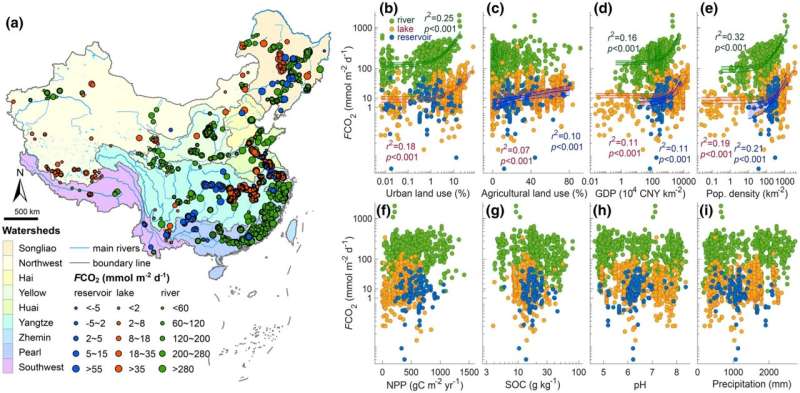How anthropogenic disturbances drive inland water CO2 emissions

Carbon emissions from rivers, lakes, and reservoirs make up a large proportion of the global carbon cycle. Recent studies on carbon emission from inland waters in China have been focused on single lakes or rivers, and the underlying factors driving CO2 emissions remain unclear.
Recently, a research group led by Prof. Zhang Yunlin from the Nanjing Institute of Geography and Limnology of the Chinese Academy of Sciences compiled meta data from literatures with measured data on efflux of CO2 from inland waters and obtained a total of 1,405 measurements, including 658 river sites, 625 lake sites, and 122 reservoir sites sampled primarily between 2010 and 2020, and investigated the effluxes of CO2 and drivers across inland waters in China.
This work was published in Global Change Biology on Oct. 10.
Based on several data sharing platforms, the researchers obtained a series of data products including land use and land cover, gross primary productivity (GPP) and net primary productivity (NPP) at spatial resolutions of 30 m and 1 km. Then, they extracted data on catchment urban and agricultural land use, gross domestic product (GDP), population density, NPP, topsoil organic carbon, topsoil pH, and precipitation.
"Through analyzing these data products, we unravel the driven mechanisms of CO2 efflux from lakes, reservoirs and rivers in China," said Prof. Zhang.
The researchers found notably higher CO2 efflux from rivers than from lakes and reservoirs. The effluxes of CO2 from rivers and lakes increased significantly with the increasing catchment urban land use, and CO2 effluxes of lakes and reservoirs increased significantly with increasing catchment agricultural land use.
The effluxes of CO2 from lakes, reservoirs, and rivers increased with increasing catchment GDP and population density. In comparison, no significant relationships were found between the CO2 efflux and catchment annual NPP, topsoil organic carbon concentration, pH of topsoil, or catchment precipitation.
Previous studies have found that compared to less populated regions, the increase in population density results primarily in eutrophication of inland waters caused by the discharge of agricultural, industrial, and residential effluents, as well as nonpoint sources of organic carbon. In eutrophic waters, primary production is commonly increased with high amounts of bio-labile organic matter, favoring microbial degradation and thereby strongly enhancing the CO2 production and emission from inland waters.
These results suggest that anthropogenic disturbances in relation to urbanization and agricultural land use can influence CO2 emissions from inland waters more than catchment productivity, which previously has been identified as the main driver for CO2 emissions from inland waters in less populated regions.
This work demonstrated that the presence of anthropogenic disturbances in catchments, represented by urban and agricultural land use, GDP, and population density, were positively related to the emission of CO2.
It highlighted the importance of in-situ production of CO2 via the degradation of household effluents, nonpoint source- and algal-organic carbon in catchments draining densely populated areas compared with CO2 being directly delivered through inflowing catchment streams.
More information: Jinling Wang et al, Urbanization in developing countries overrides catchment productivity in fueling inland water CO 2 emissions, Global Change Biology (2022). DOI: 10.1111/gcb.16475
Journal information: Global Change Biology
Provided by Chinese Academy of Sciences




















